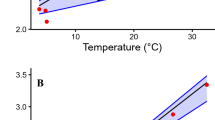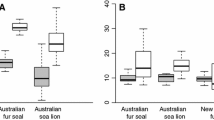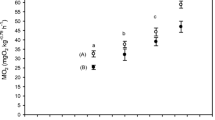Abstract
Few published studies have measured the oxygen consumption rates of elasmobranchs larger than 1.5 m, with only one measured at temperatures below 10 °C. This study provides initial measurements of the metabolic rate of three juvenile Pacific sleeper sharks, SP1904, SP1908, and SP2005 (199 cm, 162 cm, 144 cm), which were caught and temporarily housed at the Alaska SeaLife Center in Seward, Alaska. While at the Center, multiple respirometry trials were performed utilizing an intermittent-closed system respirometer to measure oxygen consumption. The average routine metabolic rates for each individual were calculated at 17.8 ± 1.3 mgO2kg−1 h−1, 20.5 ± 1.6 mgO2kg−1 h−1, and 4.0 ± NA mgO2kg−1 h−1, respectively, while the resting metabolic rate of SP1908 was calculated at 14.3 ± 2.4 mgO2kg−1 h−1. Oxygen consumption rates were measured between 6.0 and 8.8 °C. Both the active and resting metabolic rates for the Pacific sleeper shark were like those of the previously measured and closely related Greenland shark (Somniosus microcephalus) and the temperate zebra shark (Stegostoma fasciatum) when scaled to the temperature in this study. Therefore, Pacific sleeper shark metabolic rate is not unusually low compared to other shark species. These initial measurements of the metabolic rate of Pacific sleeper sharks enhance deep-sea and polar physiology knowledge by filling gaps in respirometry research for large, Arctic elasmobranchs.






Similar content being viewed by others
Data availability
The datasets generated during and analyzed during the current study are included in this published article or available from the corresponding author on reasonable request.
References
Ballantyne JS (1997) Jaws: the inside story. The metabolism of elasmobranch fishes. Comp Biochem Physiol 118B(4):703–742
Barkley AN, Cooke SJ, Fisk AT, Hedges K, Hussey NE (2017) Capture-induced stress in deep-water Arctic fish species. Polar Biol 40(1):213–220
Benson JF, Jorgensen SJ, O’Sullivan JB, Winkler C, White CF, Garcia-Rodriguez E, Sosa-Nishizaki O, Lowe CG (2018) Juvenile survival, competing risks, and spatial variation in mortality risk of a marine apex predator. J Appl Ecol 55(6):2888–2897
Bernal D, Lowe CG (2015) Field studies of elasmobranch physiology, in: Shadwick, R.E., Farrell, A.P., & Brauner, C.J. (Eds.), Fish Physiology. Oxford, UK: Academic Press, 34A:311–377
Brett J, Blackburn J (1978) Metabolic rate and energy expenditure of the spiny dogfish, Squalus acanthias. J Fish Board Can 35(6):816–821
Bushnell PG, Lutz PL, Gruber SH (1989) The metabolic rate of an active, tropical elasmobranch, the lemon shark (Negaprion brevirostris). Exp Biol 48:279–283
Carlson JK, Parson GR (1999) Seasonal differences in routine oxygen consumption rates of the bonnethead shark. J Fish Biol 55:876–879
Carlson JK, Parsons GR (2001) The effects of hypoxia on three sympatric shark species: physiological and behavioral responses. Environ Biol Fishes 61(4):427–433
Carlson JK, Parsons GR (2003) Respiratory and hematological responses of the bonnethead shark, Sphyrna tiburo, to acute changes in dissolved oxygen. J Exp Mar Biol Ecol 294(1):15–26. https://doi.org/10.1016/s0022-0981(03)00237-5
Childress JJ, Somero GN (1979) Depth-related enzymic activities in muscle, brain and heart of deep-living pelagic marine teleosts. Mar Biol 52:273–283
Choromanski JM, Bulman FE, Handsel TH, George RH, Batt JH, Harvey-Clark C, Gallant JJ (2017) Collection, transport and handling of the Greenland shark, Somniosus microcephalus. In M. Smith, D. Warmolts, D. Thoney, R. Hueter, M. Murray, & J. Ezcurra (Eds.), Elasmobranch Husbandry Manual II: Recent Advances in the Care of Sharks, Rays and their Relatives. 33–42
Corner E, Denton EJ, Forster G (1969) On the buoyancy of some deep-sea sharks. Proceedings of the Royal Society of London. Series B Biol Sci 171(1025):415–429
Cortés E, Papastamatiou YP, Carlson JK, Ferry-Graham L, Wetherbee BM, Cyrino, J, Bureau DP, Kapoor B (2008) An overview of the feeding ecology and physiology of elasmobranch fishes. Feed Dig Funct Fish 393–443
Courtney DL, Adkison MD, Sigler MF (2016) Risk analysis of plausible incidental exploitation rates for the Pacific sleeper shark, a data-poor species in the Gulf of Alaska. North Am J Fish Manag 36:523–548
Di Santo V, Bennett WA (2011) Effect of rapid temperature change on resting routine metabolic rates of two benthic elasmobranchs. Fish Physiol Biochem 37(4):929–934. https://doi.org/10.1007/s10695-011-9490-3
Dowd W, Brill RW, Bushnell PG, Musick JA (2006) Standard and routine metabolic rates of juvenile sandbar sharks (Carcharhinus plumbeus), including the effects of body mass and acute temperature change. Fish Bull 104:323–331
Edwards JE, Hiltz E, Broell F, Bushnell PG, Campana SE, Christiansen JS, Devine BM, Gallant JJ, Hedges KJ, MacNeil MA, McMeans BC, Nielsen J, Pr æbel K, Skomal GB, Steffensen JF, Walter RP, Watanabe YY, VanderZwaag DL, Hussey NE (2019) Advancing research for the management of long-lived species: a case study on the Greenland shark. Front Mar Sci 6:87
Ferry-Graham LA (2001) Gibb ACJC (2001) Comparison of fasting and postfeeding metabolic rates in a sedentary shark. Cephaloscyllium Ventriosum Copeia 4:1108–1113
Fujiwara Y, Matsumoto Y, Sato T, Kawato M, Tsuchida S (2021) First record of swimming speed of the Pacific sleeper shark Somniosus pacificus using a baited camera array. J Mar Biol Assoc UK 101(2):457–464
Graham JB, Dewar H, Lai NC, Lowell WR, Arce SM (1990) Aspects of shark swimming performance determined using a large water tunnel. J Exp Biol 151(1):175–192
Hartill ÉC, Waller RG, Auster PJ (2020) Deep coral habitats of Glacier Bay National Park and Preserve, Alaska. PLoS One 15(8):e0236945
Hendry AP, Berg OK, Quinn TP (1999) Condition dependence and adaptation-by-time: breeding date, life history, and energy allocation within a population of salmon. Oikos 85:499–514
Hulbert L, Sigler M, Lunsford C (2006) Depth and movement behaviour of the Pacific sleeper shark in the north-east Pacific Ocean. J Fish Biol 69(2):406–425
Hussey NE, Cosandey-Godin A, Walter RP, Hedges KJ, VanGerwen-Toyne M, Barkley AN, Kessel ST, Fisk AT (2015) Juvenile Greenland sharks Somniosus microcephalus (bloch & Schneider, 1801) in the Canadian arctic. Polar Biol 38(4):493–504
Larsson Å, Johansson-Sjöbeck M-L, Fänge R (1976) Comparative study of some haematological and biochemical blood parameters in fish from the Skagerrak. J Fish Biol 9:425–440
Lowe CG (2001) Metabolic rates of juvenile scalloped hammerhead sharks (Sphyrna lewini). Mar Biol 139:447–453. https://doi.org/10.1007/s002270100585
Lowe CG (2002) Bioenergetics of free-ranging juvenile scalloped hammerhead sharks (Sphyrna lewini) in Kane’ohe Bay, O’ahu, HI. J Exp Mar Biol Ecol 278:141–156
Luongo SM, Lowe CG (2018) Seasonally acclimated metabolic Q 10 of the California horn shark, Heterodontus francisci. J Exp Mar Biol Ecol 503:129–135. https://doi.org/10.1016/j.jembe.2018.02.006
Nielsen J, Hedeholm RB, Heinemeier J, Bushnell PG, Christiansen JS, Olsen J, Ramsey CB, Brill RW, Simon M, Steffensen KF, Steffensen JF (2016) Eye lens radiocarbon reveals centuries of longevity in the Greenland shark (Somniosus microcephalus). Science 353(6300):702–704. https://doi.org/10.1126/science.aaf1703
Nielsen Julius, Hedeholm Rasmus B., Lynghammar Arve, McClusky Leon M., Berland Bjørn, Steffensen John F., Christiansen Jørgen S., Munroe Samantha E. M. (2020) Assessing the reproductive biology of the Greenland shark (Somniosus microcephalus). PLoS One 15(10):e0238986. https://doi.org/10.1371/journal.pone.0238986
Norin T, Malte H (2012) Intraspecific variation in aerobic metabolic rate of fish: relations with organ size and enzyme activity in brown trout. Physiol Biochem Zool 85(6):645–656. https://doi.org/10.1086/665982
Northwest Atlantic Fisheries Organization (2018) Report of the scientific council meeting (Serial No. N6849 NAFO SCS Doc. 18–19). Halifax. Nova Scotia
Orlov AM (2017) The Pacific sleeper shark Somniosus pacificus: A deterrence for existing fisheries or a promising target? Adv Med Biol 119:277–289
Orlov AM, Baitalyuk AA (2014) Spatial distribution and features of biology of Pacific sleeper shark Somniosus pacificus in the North Pacific. J Ichthyol 54(8):526–546. https://doi.org/10.1134/s0032945214040080
Payne NL, Snelling EP, Fitzpatrick R, Seymour J, Courtney R, Barnett A, Watanabe YY, Sims DW, Squire L Jr, Semmens JM (2015) A new method for resolving uncertainty of energy requirements in large water breathers: the ‘mega-flume’ seagoing swim-tunnel respirometer. Methods Ecol Evol 6(6):668–677. https://doi.org/10.1111/2041-210x.12358
Piiper J, Meyer M, Worth H, Willmer H (1977) Respiration and circulation during swimming activity in the dogfish Scyliorhinus stellaris. Respir Physiol 30(1–2):221–239
Prohaska BK, Talwar BS, Grubbs RD (2021) Blood biochemical status of deep-sea sharks following longline capture in the Gulf of Mexico. Conserv Physiol 9(1). https://doi.org/10.1093/conphys/coaa113
Scharold J (1991) Gruber SH (1991) Telemetered heart rate as a measure of metabolic rate in the lemon shark, Negaprion brevirostris. Am Soc Ichthyologists Herpetologists 4:942–953
Sepulveda CA, Graham JB, Bernal D (2007) Aerobic metabolic rates of swimming juvenile mako sharks Isurus Oxyrinchus. Mar Biol 152(5):1087–1094. https://doi.org/10.1007/s00227-007-0757-2
Sims DW (1996) The effect of body size on the standard metabolic rate of the lesser spotted dogfish. J Fish Biol 48:542–544
Steffensen JF (2005) Respiratory systems and metabolic rates. Fish Physiology 22:203–238
Ste-Marie E, Watanabe YY, Semmens JM, Marcoux M, Hussey NE (2020) A first look at the metabolic rate of Greenland sharks (Somniosus microcephalus) in the Canadian Arctic. Sci Rep 10(1):1–8
Svendsen MB, Bushnell PG, Steffensen JF (2016) Design and setup of intermittent-flow respirometry system for aquatic organisms. J Fish Biol 88(1):26–50. https://doi.org/10.1111/jfb.12797
Tribuzio CA, Rodgveller C, Echave K, Hulson P-J (2018) Assessment of the shark stock complex in the Gulf of Alaska. NPMC Gulf of Alaska SAFTE (Gulf of Alaska Sharks) 1–78
Tribuzio CA, Matta ME, Echave K, Rodgveller C (2020) Assessment of the Shark Stock Complex in the Gulf of Alaska. NPFMC Gulf of Alaska SAFE (Gulf of Alaska Sharks) 1–70
Waller RG, Stone RP, Johnstone J, Mondragon J (2014) Sexual reproduction and seasonality of the Alaskan red tree coral Primnoa Pacifica. PLoS One 9(4):e90893
Walter RP, Roy D, Hussey NE, Stelbrink B, Kovacs KM, Lydersen C, McMeans BC, Svavarsson J, Kessel ST, Porsmoguer SB, Wildes S, Tribuzio CA, Campana SE, Petersen SD, Grubbs RD, Heath DD, Hedges KJ, Fisk AT (2017) Origins of the Greenland shark (Somniosus microcephalus): impacts of ice-olation and introgression. Ecol Evol 7(19):8113–8125. https://doi.org/10.1002/ece3.3325
Wetherbee BM, Nichols PD (2000) Lipid composition of the liver oil of deep-sea sharks from the Chatham Rise, New Zealand. Comp Biochem Physiol b: Biochem Mol Biol 125(4):511–521
Whitney NM, Lear KO, Gaskins LC, Gleiss AC (2016) The effects of temperature and swimming speed on the metabolic rate of the nurse shark (Ginglymostoma cirratum, Bonaterre). J Exp Mar Biol Ecol 477:40–46. https://doi.org/10.1016/j.jembe.2015.12.009
Yano K, Stevens JD, Compagno LJ (2004) A review of the systematics of the sleeper shark genus Somniosus with redescriptions of Somniosus (Somniosus) antarcticus and Somniosus (Rhinoscymnus) longus (Squaliformes: Somniosidae). Icthyological Res 51(4):360–373
Yano K, Stevens JD, Compagno LJV (2007) Distribution, reproduction and feeding of the Greenland shark Somniosus (Somniosus) microcephalus, with notes on two other sleeper sharks, Somniosus (Somniosus) pacificus and Somniosus (Somniosus) antarcticus. J Fish Biol 70(2):374–390
Acknowledgements
This paper is dedicated to the memory of Richard Hocking, his vast knowledge and support were integral throughout the entirety of this project. We thank Andy Mezirow for his insights on catching Pacific sleeper sharks locally out of Seward, and assistance in developing our fishing techniques. We thank the CSULB Shark Lab graduate students for paper revisions and all the staff and volunteers at ASLC for field work as well as respirometry support.
Funding
This project could not have been completed without the funding from the North Pacific Research Board awards R1711, R2004, graduate student grant 1921 and additional funding from the California State University Council on Ocean Affairs, Science & Technology graduate student research award and Southern California Tuna Club Marine Biology Foundation.
Author information
Authors and Affiliations
Contributions
CL and MH conceived and designed the project. TS, AB, JG, RH, and MH conducted field work, husbandry, and experiments. TS analyzed data and wrote the manuscript. All authors read and approved the manuscript.
Corresponding author
Ethics declarations
Ethics approval
All captures, handling, and procedures of the Pacific Sleeper shark were permitted under Aquatic Resource Use Permit No. CF-18–041; CF-19–085; CF-20–081 issued by the Alaska Department of Fish and Game. All husbandry of the Pacific sleeper shark was permitted under AUP No. R18-04–02; R19-05–05 by the ASLC’s IACUC.
Conflict of interest
The authors declare no competing interests.
Additional information
Publisher's note
Springer Nature remains neutral with regard to jurisdictional claims in published maps and institutional affiliations.
Rights and permissions
Springer Nature or its licensor holds exclusive rights to this article under a publishing agreement with the author(s) or other rightsholder(s); author self-archiving of the accepted manuscript version of this article is solely governed by the terms of such publishing agreement and applicable law.
About this article
Cite this article
Smith, T.R., Bishop, A., Guthridge, J. et al. Capture, husbandry, and oxygen consumption rate of juvenile Pacific sleeper sharks (Somniosus pacificus). Environ Biol Fish 105, 1519–1534 (2022). https://doi.org/10.1007/s10641-022-01334-5
Received:
Accepted:
Published:
Issue Date:
DOI: https://doi.org/10.1007/s10641-022-01334-5




